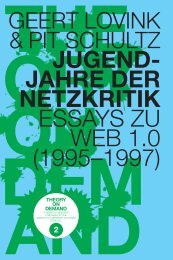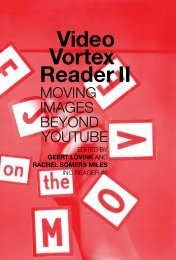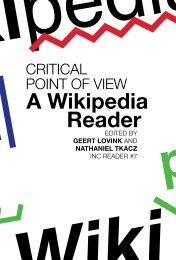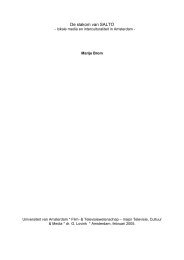Download PDF - Institute of Network Cultures
Download PDF - Institute of Network Cultures
Download PDF - Institute of Network Cultures
You also want an ePaper? Increase the reach of your titles
YUMPU automatically turns print PDFs into web optimized ePapers that Google loves.
Arjon Dunnewind - 'Impakt Channel: Content with Context'. Photo by Anne Helmond.<br />
By Stijnie Thuijs<br />
Being the festival, artistic and general director <strong>of</strong> Impakt, Arjon Dunnewind is in charge <strong>of</strong><br />
a database <strong>of</strong> art related content for which he has to decide the most appropriate way <strong>of</strong><br />
uploading to the web. An important factor to take into account, he explains, is that the<br />
audience on the web has different expectations than ʻ<strong>of</strong>fline audienceʼ. Online archives<br />
are the next phase and make us rethink how we structure the art collection, connect both<br />
the online and <strong>of</strong>fline audience and exploit the merits <strong>of</strong> the online environment to use<br />
them in the best possible way.<br />
How to involve an audience?<br />
According to Dunnewind this can be done by providing the viewers quality instead <strong>of</strong><br />
quantity. This means no comment space below the art content. Arjon would rather have<br />
a platform without any comments than low quality comments and spam on his channel.<br />
Moderation and hierarchy are keywords for the Impakt Channel, only inviting experts to<br />
give their opinion and opening little by little. Arjon wouldnʼt mind never to open it for<br />
ordinary users though – as it can degrade the quality.<br />
Legal issues<br />
: A struggle for Dunnewind are the legal issues. Foremost, who is responsible for the<br />
content and the legal issues is not always clear. While being online for supposedly 20<br />
years, only since 5 years has there been options for artists as to in which degree their<br />
work is allowed to be published. There is no standard agreement with the artists (all<br />
permission has to be confirmed in direct contact with the artist) and more importantly:<br />
the artists themselves havenʼt always cleared the legal issues <strong>of</strong> the materials used in<br />
their pieces. On the sunny side <strong>of</strong> the legal issues is that the organization is relatively<br />
small, so they donʼt receive a lot <strong>of</strong> complaints. Also there is not much historical material<br />
in the database and the legal methods Impakt uses now actually bond the artist and the<br />
organization really well. Which results in allowing to put the work online.<br />
The Impakt Channel : Give context to content. Or: how to make a difference<br />
: To differentiate yourself from video websites such as YouTube – which <strong>of</strong>fer little to no<br />
context - could be done in various ways. To Arjon, a way is to do that is to <strong>of</strong>fer unique<br />
content. Also building a unique platform with alternate possibilities and limitations is a<br />
manner. Furthermore, connecting the online channel with the <strong>of</strong>fline events, art projects<br />
and festivals, including bonus material for example, are adequate ways to create<br />
context. As are the display <strong>of</strong> background information, articles, introductions and<br />
comments by invited experts, interviews and curatorial texts from the original programs.<br />
All that said, Arjon concludes with his wish for the online Impakt environment. ʻWe want<br />
the Impakt Channel to become a new platformʼ, he says. A platform that creates<br />
exhibitions online, a flexible, dynamic, autonomous space on which can be<br />
experimented.<br />
20







